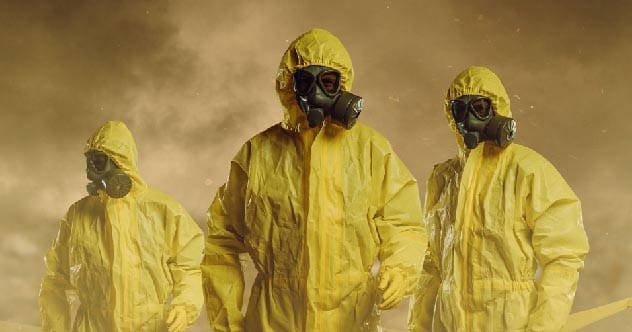The world is battling the coronavirus pandemic, but several near pandemics in recent history could have been far deadlier. These diseases were contained thanks to the tireless efforts of healthcare workers. Had they slipped through, the consequences would have been catastrophic. Let’s explore 10 recent near pandemics that posed a greater threat than COVID-19.
Ebola
Ebola, a highly lethal disease, originated in western Africa in 1976. The most likely cause is human contact with infected primates. Early symptoms include fever, headache, muscle pain, and chills. However, it quickly escalates to internal bleeding, causing vomiting or coughing up blood. Ebola spreads through bodily fluids of infected individuals or those who have recently died from it. Some strains have a mortality rate of nearly 75%.
The deadliest outbreak occurred from 2013 to early 2016, with 28,646 cases and 11,323 deaths. West African nations were devastated, with up to 59% of hospitalized patients dying. Rigorous contact tracing and quarantine measures were crucial in ending the pandemic. Vaccines were used sparingly due to limited testing but have since been used to control smaller outbreaks.
AIDS
In the early 1980s, little was known about HIV/AIDS. First identified in Los Angeles, San Francisco, and New York in 1981, some experts believe it may have been present in humans since the 1960s. Early transmission was traced to non-human primates. Misconceptions surrounded HIV/AIDS, including the debunked “patient zero” theory involving Gaëtan Dugas.
Over 700,000 people have died from HIV/AIDS in the U.S. since 1981. It disproportionately affected gay and bisexual men and was initially termed “gay cancer.” The virus spreads through sexual intercourse or blood contact. Treatment has improved significantly, with antiviral drugs preventing progression to AIDS in many cases.
SARS
The SARS (Severe Acute Respiratory Syndrome) epidemic emerged in the early 2000s, originating in China and spreading to East Asia and the United States. Around 8,000 people were infected, with nearly 1,000 deaths. Symptoms included fever, aches, diarrhea, and pneumonia. SARS spread through respiratory droplets when an infected person coughed or sneezed.
The media labeled SARS the first pandemic of the 21st century. With a 10% mortality rate, it was deadlier than COVID-19. The WHO and CDC restricted travel to contain the virus. The United States saw only eight cases, thanks to effective preventive measures.
Swine Flu
The 2009 H1N1 virus, or swine flu, caused an 11-month worldwide pandemic. This influenza strain is also responsible for the Spanish Flu and Russian Flu. The virus arose from a mix of genetic material from bird, swine, and human flu viruses, combined with the Eurasian pig flu virus.
Symptoms are similar to the flu. Experts estimate 700 million to 1.4 billion cases, with 150,000 to 575,000 deaths. For comparison, the flu causes 250,000 to 500,000 deaths annually.
Cholera
A Cholera pandemic has been ongoing since 1961 in many underdeveloped nations. It spreads through consuming water contaminated with fecal matter. People in third-world nations are at higher risk, while developed nations have seen a decline due to improved sanitation. Untreated cholera can be fatal within hours.
Symptoms include diarrhea, vomiting, thirst, and dehydration, appearing 2 hours to 5 days after exposure. The last U.S. outbreak ended in 1866, killing up to 1/10 of people in large cities. Fighting cholera involves providing sanitation services, clean water, and selective vaccination.
Typhoid Fever
Typhoid is a bacterial disease that can be spread asymptomatically. Common symptoms include high fever, abdominal pain, headaches, and constipation. Some patients develop rose-colored skin rashes. Symptoms are caused by bacterial growth in the blood and intestines.
In 1906, Mary Mallon, or “Typhoid Mary,” was the first asymptomatic carrier in the U.S., infecting about 53 people as a cook. She was quarantined but returned to cooking, eventually being forced into isolation for 30 years. The epidemic ended due to widespread vaccine usage, with 40-90% effectiveness lasting up to 7 years.
Whooping Cough
Whooping cough, or the “100-day cough,” can last up to 10 weeks. It’s a highly contagious bacterial disease spread through droplets from sneezes or coughs. Initial symptoms resemble the common cold, followed by violent coughing fits lasting weeks. After coughing fits, a high-pitched whoop sound may be heard when breathing in.
Whooping cough affects 16 million people yearly, primarily in developing nations, with about 61,000 deaths. Outbreaks have diminished in the U.S. due to vaccines, but some occurred in the early 2010s. These outbreaks were partly due to vaccine refusal for non-medical reasons.
Measles

The Measles virus spreads through coughs, sneezes, and contact with nasal secretions. Symptoms appear 10-12 days after exposure and last 7-10 days. Initial symptoms include high fever, cough, runny nose, and inflamed eyes. Koplik’s spots, small white spots inside the mouth, may develop two to three days later.
The measles rash develops on the face and spreads to the body. Measles was considered eradicated from the Americas in 2016, but cases have continued. A 1991 Philadelphia outbreak infected 1400 people and killed nine children, originating from a church discouraging vaccination.
Polio
Poliomyelitis is caused by the poliovirus, spread through ingesting infected feces and rarely through saliva. Most infected people have no symptoms, and about a quarter experience mild flu-like symptoms. In 1/200 cases, the virus invades the central nervous system, causing muscle weakness, especially in the legs.
Weakness may involve head, neck, and diaphragm muscles, sometimes needing an iron lung for breathing. In victims with muscle weakness, 2-5% of children and 15-30% of adults die. The U.S.’s first polio epidemic began in 1894. Polio was eliminated in the Americas in 1994 due to vaccination efforts.
Smallpox
Smallpox wasn’t fully eradicated until 1978. Its origin is unknown, but evidence suggests it existed before the third century BCE. The last major U.S. outbreak was in 1902. Initial symptoms include fever and vomiting, developing into ulcers and fluid-filled blisters with a dent in the middle.
Blisters scab, fall off, and leave scars. The last outbreak began in 1901, lasting three years with 1596 cases and nearly 300 deaths, a 17% fatality rate. The smallpox vaccine is the primary reason for the disease’s eradication.
These near pandemics remind us of the constant threat of infectious diseases. Vigilance, research, and public health measures are crucial to prevent future catastrophes.
What do you think is the most concerning disease on this list? Leave your comment below!










